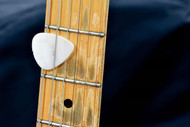DIY: Crafting Your Own Guitar Pick at Home
May 16th 2024

DIY: Crafting Your Own Guitar Pick at Home
Guitarists can visit Strings and Beyond and shop for hundreds of fun guitar picks that draw a certain sound and feel from your axe. Another option is to make a guitar pick. A homemade guitar pick is a fun DIY project that is also practical. It lets you recycle old objects and materials, and it gives the pick a unique personality that mass-produced picks don’t have.
Another reason some people make their picks is to customize the thickness, flexibility, color and even shape. For example, while 0.73mm and 0.88mm picks are common, you might prefer something in between; a custom guitar pick lets you achieve this. You can use different materials as well for the right amount of bend, durability and smoothness.
Are you interested in making a guitar pick? Strings and Beyond has some advice for crafting homemade guitar picks that will feel good in your hand and on your guitar strings.
What Materials Can I Use to Make Guitar Picks?
Celluloid plastic and nylon are the most popular guitar pick materials, so you can’t go wrong with hard plastic or nylon sheets. The key will be getting the right thickness. This can be tricky because most plastic sheets are measured in inches or mils (thousands of an inch) whereas guitar pick thickness is measured in millimeters. Here are conversions for a few standard guitar picks to help you get started:
- 0.6mm = 0.0236 inches (1/42”) or 24 mils
- 0.8mm = 0.0315 inches (~1/32”) or 31-32 mils
- 1mm = 0.0393 inches (~1/25”) or 39 mils

What if you don’t want to buy separate materials? There are plenty of old items you may have lying around the house that can be turned into guitar picks, including:
- Credit cards, gift cards and ID cards. These plastic cards are an industry-standard 0.03 inches (30 mils) thick, which will make an all-purpose 0.76mm guitar pick. (Some cards may be thicker or thinner.)
- Insurance cards and bus passes. A bus pass is typically 0.02 inches (20 mils) thick. This translates to a 0.51mm pick, which is ideal for rhythm strummers and beginners.
- CDs and DVDs. If you want a thicker guitar pick, repurpose your old physical media. These discs are 1.2mm thick, which is excellent for jazz and other dark-toned music.
- Container lids. Before tossing that empty container of sour cream or ricotta cheese in the trash, clean off the lid and make guitar picks. They tend to be on the thinner side.
- Plastic rulers. Can’t bear to throw out your classroom ruler even though you haven’t used it in years? Turn it into a guitar pick! Note they can vary greatly in thickness.
If you want a pick made of another material, there are plenty of options. Sheets of Ultem PEI plastic or Delrin will produce a much more rigid pick, which may be preferred for guitarists who primarily play lead. You can use wood, metal, stone, cardboard and much more, though they may require more time and effort than plastic plectrums.

How to Make a Guitar Pick
Assuming you’re using plastic or another easily cuttable material, there are two ways to make guitar picks at home. The easiest method is the Pick Punch. This tool will quickly cut thin plastic and nylon into a guitar pick. The regular punch makes standard 351 picks that are 30mm tall by 25.5mm wide, which is a good all-round size. You’ll also find Baby 346 pick punches, jazz guitar pick punches, triangle punches and other shapes, meaning almost every guitarist can customize a pick to their liking.
To use a pick punch, place the plastic sheet or item in the punch, using the viewfinder to line them up. If you’re using a card that has raised numbers, consider incorporating them into the pick to provide more grip. Grab the handles and squeeze until your new pick pops out. You can smooth out sharp and rough edges using 200-grit sandpaper or a nail file. We don’t recommend decorating the pick as paint and glitter will rub off on your strings and damage them.
The other method is to manually cut your guitar pick, which requires more effort but gives you more control over the size and shape. Use a pencil to draw the shape on the material — you can freehand it or trace an outline. For cards with rounded corners, these can be the pick tip. Use scissors or a utility knife to cut the pick out, then sand the edges until they’re smooth.
Tip: Heavier and more rigid materials can sometimes crack or shatter when you try to cut them. Gently heating them beforehand will soften the material and lower the chances of this happening. Boil some water on the stove, then use the steam to heat the material.

Using Objects as Guitar Picks
If you don’t want to do any cutting or punching, there are always prefabricated objects. Queen guitarist Brian May is notorious for using old sixpence coins as guitar picks. In most cases, we recommend coins that are at least one inch across. Try to find coins made of softer metals as they are easier on the strings. Wash the coin as well to remove dirt, skin oils and bacteria.
Old SD cards and SIM cards are another way to do some DIY picking. Standard SD cards are 2.1mm thick, microSD cards are 1mm thick and SIM cards are 0.76mm thick. They usually have one or two rounded edges that you can use on the strings. Just make sure any information on them has been backed up elsewhere because it’s only a matter of time before using a memory card as a pick ruins its storage abilities.

